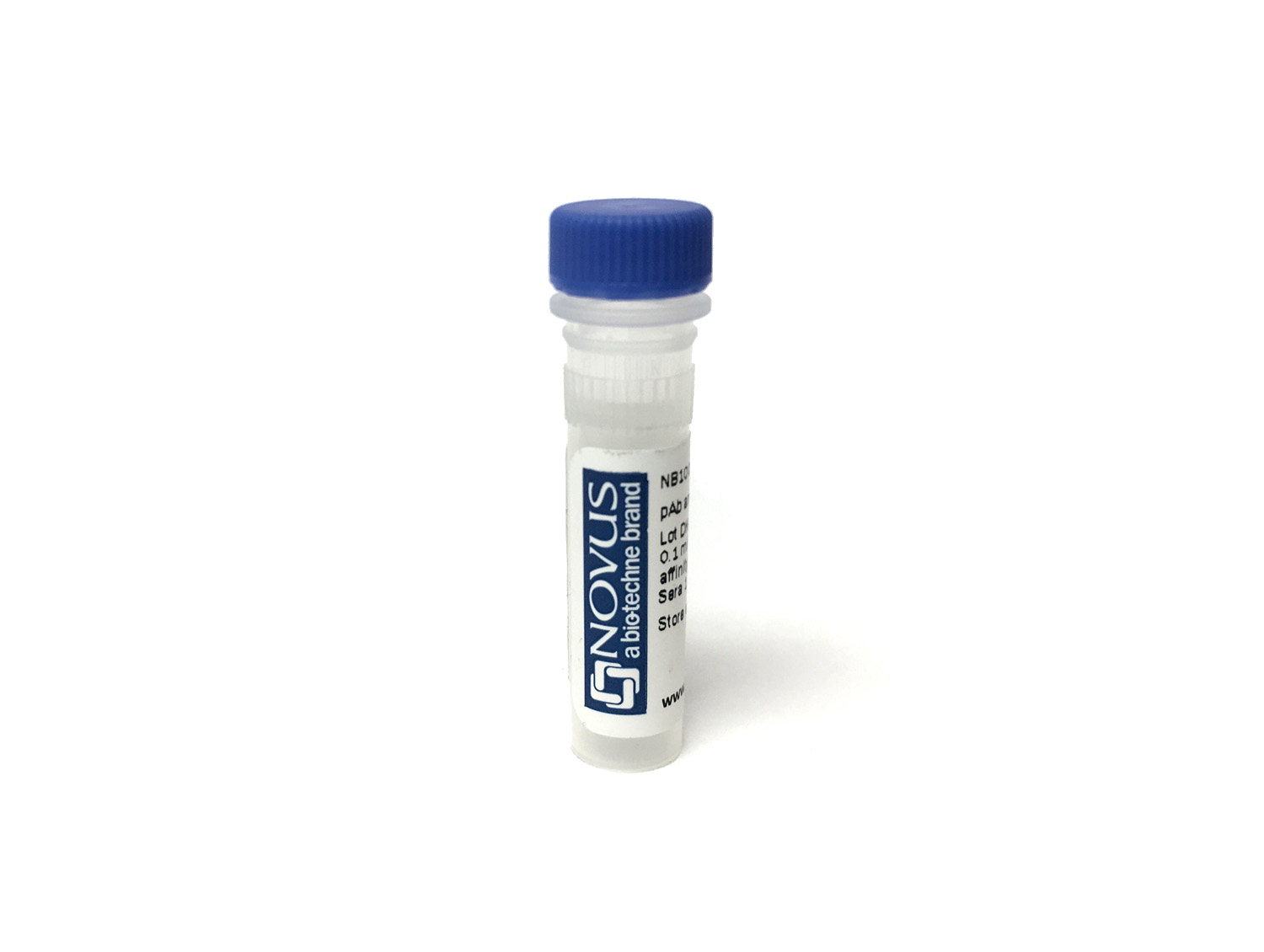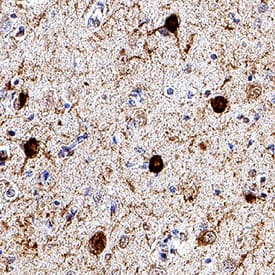Tau: Antibodies
Bio-Techne offers high quality Tau antibodies from our Novus Biologicals and R&D Systems brands. Our Tau antibodies have been cited in 25 publications with 5 5-star customer reviews. Browse our catalog for anti-Tau monoclonal, polyclonal, and recombinant monoclonal antibodies. These antibodies are reactive in target species including Human, Mouse, Rat, Bovine, Equine, and more. Our Tau antibodies have been validated for use in several research applications: Simple Western, Knockdown Validated, Immunocytochemistry/ Immunofluorescence, Western Blot, Immunohistochemistry, and more. Choose the anti-Tau antibody best suited for your research needs by viewing the technical details, images, citations, reviews, and more. Each Tau antibody is fully covered by Bio-Techne’s 100% guarantee.
Bio-Techne offers a comprehensive range of other Tau-related products including Tau Luminex Assays, Tau ELISA Kits, Tau Proteins and Enzymes, and more.
479 results for "Tau Primary Antibodies" in Products
479 results for "Tau Primary Antibodies" in Products
Tau: Antibodies
Bio-Techne offers high quality Tau antibodies from our Novus Biologicals and R&D Systems brands. Our Tau antibodies have been cited in 25 publications with 5 5-star customer reviews. Browse our catalog for anti-Tau monoclonal, polyclonal, and recombinant monoclonal antibodies. These antibodies are reactive in target species including Human, Mouse, Rat, Bovine, Equine, and more. Our Tau antibodies have been validated for use in several research applications: Simple Western, Knockdown Validated, Immunocytochemistry/ Immunofluorescence, Western Blot, Immunohistochemistry, and more. Choose the anti-Tau antibody best suited for your research needs by viewing the technical details, images, citations, reviews, and more. Each Tau antibody is fully covered by Bio-Techne’s 100% guarantee.
Bio-Techne offers a comprehensive range of other Tau-related products including Tau Luminex Assays, Tau ELISA Kits, Tau Proteins and Enzymes, and more.
Recombinant Monoclonal Antibody
| Reactivity: | Human, Mouse, Rat, Sheep |
| Details: | Rabbit IgG Kappa Monoclonal Clone #Tau-5 |
| Applications: | ICC/IF, MS |
Recombinant Monoclonal Antibody
| Reactivity: | Human, Mouse, Rat, Sheep |
| Details: | Rabbit IgG Kappa Monoclonal Clone #Tau-5 |
| Applications: | ICC/IF, MS |
Recombinant Monoclonal Antibody
| Reactivity: | Human, Mouse, Rat, Sheep |
| Details: | Rabbit IgG Kappa Monoclonal Clone #Tau-5 |
| Applications: | ICC/IF, MS |
Recombinant Monoclonal Antibody
| Reactivity: | Human, Mouse, Rat, Sheep |
| Details: | Rabbit IgG Kappa Monoclonal Clone #Tau-5 |
| Applications: | ICC/IF, MS |
| Reactivity: | Multi-Species |
| Details: | Mouse IgG1 Monoclonal Clone #965319 |
| Applications: | IHC |
| Reactivity: | Human, Mouse, Rat |
| Details: | Rabbit IgG Polyclonal |
| Applications: | IHC, WB, Mycoplasma, Simple Western |
| Reactivity: | Human, Mouse, Rat, Bovine, Porcine, +1 More |
| Details: | Mouse IgG1 Monoclonal Clone #2E9 |
| Applications: | IHC, WB, ICC/IF, Func |
Recombinant Monoclonal Antibody
| Reactivity: | Human |
| Details: | Rabbit IgG Monoclonal Clone #HL1276 |
| Applications: | WB, ELISA |
| Reactivity: | Multi-Species |
| Details: | Mouse IgG1 Monoclonal Clone #376720 |
| Applications: | WB, IHC |
| Reactivity: | Multi-Species |
| Details: | Goat IgG Polyclonal |
| Applications: | WB, IHC |
Recombinant Monoclonal Antibody.
| Reactivity: | Human, Mouse, Rat |
| Details: | Rabbit IgG Monoclonal Clone #SN62-09 |
| Applications: | IHC, WB, ICC/IF |
| Reactivity: | Human, Mouse, Rat, Bovine, Porcine, +1 More |
| Details: | Chicken IgY Polyclonal |
| Applications: | IHC, WB, ICC/IF |
| Reactivity: | Human, Mouse, Rat |
| Details: | Rabbit IgG Polyclonal |
| Applications: | IHC, WB, Simple Western |
Recombinant Monoclonal Antibody
| Reactivity: | Human, Mouse, Rat |
| Details: | Rabbit IgG Monoclonal Clone #HL2802 |
| Applications: | IHC, WB, ICC/IF, Mycoplasma |
| Reactivity: | Human, Mouse, Rat |
| Details: | Mouse IgG1 Monoclonal Clone #5B10 |
| Applications: | IHC, WB, ICC/IF |
Recombinant Monoclonal Antibody
| Reactivity: | Human, Mouse, Rat |
| Details: | Rabbit IgG Monoclonal Clone #HL2497 |
| Applications: | IHC, WB, ELISA, Mycoplasma |
Recombinant Monoclonal Antibody
| Reactivity: | Human, Mouse, Rat |
| Details: | Rabbit IgG Monoclonal Clone #HL2736 |
| Applications: | WB, ICC/IF, Mycoplasma |
| Reactivity: | Human, Mouse, Rat |
| Details: | Rabbit IgG Polyclonal |
| Applications: | IHC, WB |
| Reactivity: | Human, Mouse, Rat |
| Details: | Rabbit IgG Polyclonal |
| Applications: | IHC, WB, ELISA |
| Reactivity: | Human |
| Details: | Mouse IgG2b Monoclonal Clone #1032501 |
| Applications: | IHC |
| Reactivity: | Human |
| Details: | Mouse IgG2b Monoclonal Clone #1032714 |
| Applications: | IHC |
| Reactivity: | Multi-Species |
| Details: | Mouse IgG1 Monoclonal Clone #376720 |
| Applications: | WB, IHC |
Recombinant Monoclonal Antibody
| Reactivity: | Human, Mouse, Rat |
| Details: | Rabbit IgG Monoclonal Clone #PSH01-05 |
| Applications: | IHC, WB |
Recombinant Monoclonal Antibody
| Reactivity: | Human, Mouse |
| Details: | Rabbit IgG Monoclonal Clone #AH36 |
| Applications: | IHC, WB, ICC/IF, DB |
Recombinant Monoclonal Antibody
| Reactivity: | Human, Mouse, Rat |
| Details: | Rabbit IgG Monoclonal Clone #SN62-09 |
| Applications: | IHC, WB, ICC/IF |


![Product Feature: CoraFluor Probes for TR-FRET Tau Antibody (Tau-5) [CoraFluor™ 1]](https://resources.bio-techne.com/images/products/nbp2-81091cl1_rabbit-tau-mab-tau-5-corafluor-1-129202514373113.png)


![Western Blot: Tau [p Thr181] Antibody [NB100-82245] Western Blot: Tau [p Thr181] Antibody [NB100-82245]](https://resources.bio-techne.com/images/products/Tau-[p-Thr181]-Antibody-Western-Blot-NB100-82245-img0006.jpg)
![Western Blot: Tau Antibody (2E9) [NBP2-25162] Western Blot: Tau Antibody (2E9) [NBP2-25162]](https://resources.bio-techne.com/images/products/Tau-Antibody-2E9-Western-Blot-NBP2-25162-img0006.jpg)
![Western Blot: Rabbit Tau [p Thr217] mAb (HL1276) - Tau [p Thr217] Antibody (HL1276) - Azide and BSA Free](https://resources.bio-techne.com/images/products/nbp3-45156_rabbit-tau-p-thr217-mab-hl1276-azide-and-bsa-free-western-blot-2942025165210..jpg)



![Western Blot: Tau Antibody [NBP2-25163] Western Blot: Tau Antibody [NBP2-25163]](https://resources.bio-techne.com/images/products/Tau-Antibody-Western-Blot-NBP2-25163-img0005.jpg)
![Western Blot: Tau [p Ser396] Antibody [NB100-82243] Western Blot: Tau [p Ser396] Antibody [NB100-82243]](https://resources.bio-techne.com/images/products/Tau-[p-Ser396]-Antibody-Western-Blot-NB100-82243-img0003.jpg)
![Western Blot: Rabbit Tau mAb (HL2802) [NBP3-45161] - Tau Antibody (HL2802) - Azide and BSA Free](https://resources.bio-techne.com/images/products/nbp3-45161_rabbit-tau-mab-hl2802-azide-and-bsa-free-western-blot-2942025163536..jpg)
![Western Blot: Tau Antibody (5B10) [NBP2-50051] Western Blot: Tau Antibody (5B10) [NBP2-50051]](https://resources.bio-techne.com/images/products/Tau-Antibody-5B10-Western-Blot-NBP2-50051-img0005.jpg)
![Western Blot: Rabbit Tau [p Thr181] mAb (HL2497) [NBP3-45157] - Tau [p Thr181] Antibody (HL2497) - Azide and BSA Free](https://resources.bio-techne.com/images/products/nbp3-45157_rabbit-tau-p-thr181-mab-hl2497-azide-and-bsa-free-western-blot-294202517153..jpg)
![Western Blot: Rabbit Tau mAb (HL2736) [NBP3-45160] - Tau Antibody (HL2736) - Azide and BSA Free](https://resources.bio-techne.com/images/products/nbp3-45160_rabbit-tau-mab-hl2736-azide-and-bsa-free-western-blot-3042025124758..jpg)
![Western Blot: Tau [p Thr231] Antibody [NB100-82249] Western Blot: Tau [p Thr231] Antibody [NB100-82249]](https://resources.bio-techne.com/images/products/Tau-[p-Thr231]-Antibody-Western-Blot-NB100-82249-img0002.jpg)
![Western Blot: Tau [p Thr217] Antibody [NBP3-13481] Western Blot: Tau [p Thr217] Antibody [NBP3-13481]](https://resources.bio-techne.com/images/products/Tau-[p-Thr217]-Antibody-Western-Blot-NBP3-13481-img0001.jpg)


![Western Blot: Tau [p Thr231] Antibody (PSH01-05) [NBP3-32810] Tau [p Thr231] Antibody (PSH01-05)](https://resources.bio-techne.com/images/products/nbp3-32810_rabbit-tau-p-thr231-mab-psh01-05-288202412461665.jpg)

![Immunohistochemistry-Paraffin-NBP3-21454-Tau [p Ser396] Antibody (SN62-09)- Tau [p Ser396] Antibody (SN62-09)](https://resources.bio-techne.com/images/products/antibody/nbp3-21454_rabbit-tau-p-ser396-mab-sn62-09-immunohistochemistry-paraffin-16820239811.jpg)